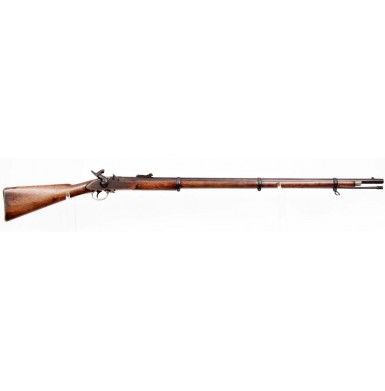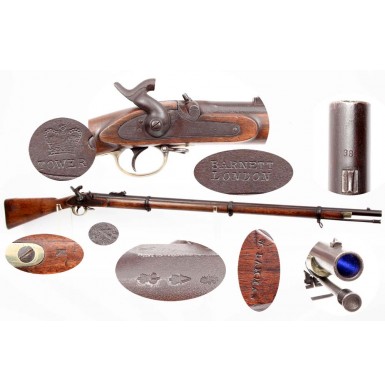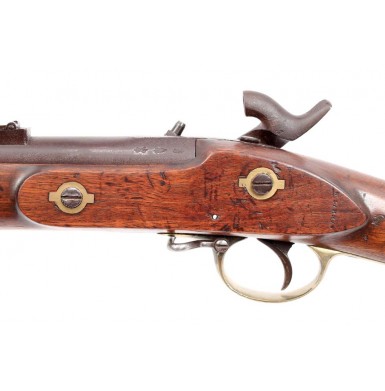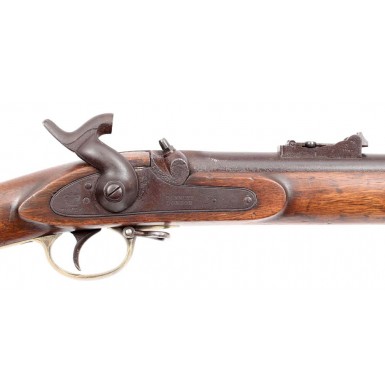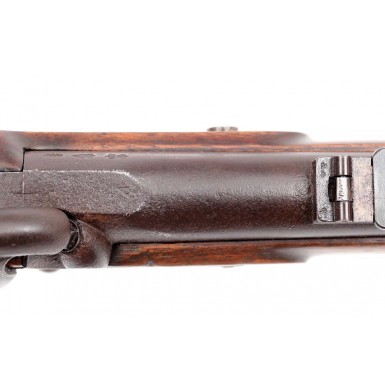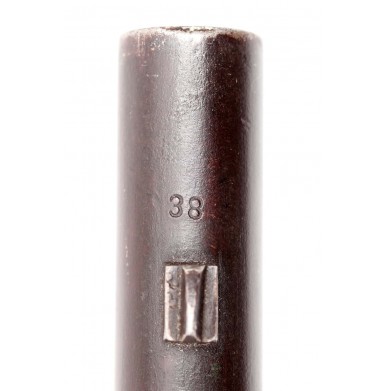Barnett Contract P-1853 with Enigmatic K Mark
- Product Code: FLA-2801-SOLD
- Availability: Out Of Stock
-
$1.00
There is no English gun maker who could more appropriately be called the “Gun Maker to the Confederacy” than the London firm of John Edward Barnett & Sons. During the course of the American Civil War, Barnett delivered thousands of P-1853 “Enfield” rifle muskets, as well as P-1853 artillery and P-1856 cavalry carbines to the Confederacy. Barnett not only filled Confederate central government contracts, but also orders for the Confederates states of Georgia, North Carolina, and South Carolina. The Barnett family traced their gunmaking heritage to Thomas Barnett who operated in London as early as 1796. In 1811 the firm became Thomas Barnett & Sons, and John Edward Barnett subsequently succeeded to the business in 1833. In 1842 the firm was renamed JE Barnett & Sons and operated under that name until 1901 when they became JE Barnett & Sons LTD, going out of business in 1908. During the Civil War years, the Barnetts operated at both their 134 Minories address, which had been established in 1833, and at Brewhouse Lane, Wapping, where they operated from 1860-1874. In the typical fashion of the old time gunmakers in England, Barnett relied heavily on a variety of contractors to produce piecework parts, which were subsequently assembled into complete arms in the Barnett shop. While Barnett could clearly manufacture entire guns in house (and often did), it was often more expedient and cost effective to sub-contract for major components when large contracts were received and had to be delivered quickly. Many of the orders received from the Confederacy during the course of the American Civil War were just these types of orders, which had to be completed as quickly as possible. It is not uncommon to disassemble a P-1853 rifle musket with a Barnett marked lock, only to discover that the gun may have been assembled by Barnett, but that few (if any of the components) were produced by Barnett. These guns often bear Confederate viewers marks such as the small CH/1 in circle, or one of the known marks of Sinclair, Hamilton & Company “ a primary supplier of English arms and materiel to the Confederacy. Even those Barnett arms devoid of documented Confederate inspection marks are often Confederate related arms. Barnett delivered a number of guns, presumably to the Confederacy, that were assembled by other makers, but are marked BARNETT / LONDON either on the stock flat opposite the lock or along the toe of the stock. These were clearly guns purchased by Barnett to get a nearly finished order “out the door” as expeditiously as possible. Sometimes the presence of a previously undocumented mark on a Barnett Enfield suggests Confederate use as well. In the case of the Barnett P-1853 Enfield offered here, just such a mark exists.
This Barnett P-1853 Enfield is marked in two places with a medium sized capital letter K. The first location is in the top of the stock comb, forward of the buttplate tang. This is the location that the “furnishers mark” is typically found on guns that were part of the Sinclair, Hamilton & Company “2nd Contract” with the Confederate central government. To date, the “five furnishers’ that have been documented to have delivered guns under that contract were E.P. Bond, Parker, Field & Sons, and James Kerr, all located in London, and CW James and WC Scott & Sons of Birmingham. These “five furnishers’ often marked their guns on the stock comb with a single “B”, “F”, “K”, “J” or “S”, respectively. The letter “P” has been tentatively identified as a sixth furnisher’s mark by Gordon Jones of the Atlanta History Center and myself. This mark appears to be that of Francis Preston of Manchester, a contractor better known for bayonets and edged weapons during the Civil War era than for firearms. Every single capital letter mark found on the top of the stock comb of a P-1853 Enfield has eventually been determined to be a mark relating to Confederate purchase. This Barnett P-1853 also bears the same single “K” on the top of the breech of the barrel. To date, the only definitive Confederate marks located in this area have been those of Sinclair, Hamilton & Company (an S/HC within an oval), and the N.C. mark of the North Carolina contract that was delivered by Barnett. The location of the mark on both the breech and the comb strongly suggest that this single letter “K” is a Confederate mark that has yet to be fully deciphered. The initial reaction of most experts who have viewed the mark is that it is an alternate mark for James Kerr of London. Kerr was the designer of the famous English pistol that bore his name and was the manager of the London Armoury Company in London. Kerr received at least a couple of small Confederate arms contracts personally during the Civil War, that appear to have been “kick backs’ or bonuses from his boss, Archibald Hamilton. Hamilton served as the managing director of the London Armoury Company and was the principle in the firm of Sinclair, Hamilton & Company. Kerr delivered 500 P-1853 Enfields under the 2nd Sinclair, Hamilton & Company contract with the Confederacy, and at least 80 (and possibly more) of the 800 P-1856 Sergeant’s Fusils for India Service that were purchased by the state of Georgia. Another possible meaning for the mark is that like the “NC” mark on the breech of the North Carolina contract guns, this gun was meant for delivery to “K”, but who was “K”? It could reference a Confederate Kentucky regiment, as at least one of the regiments in the Orphan Brigade was equipped with arms purchased personally by the their Colonel. It could also reference Otto Henry Kaselack, who was the owner of the Blockade Runner Gem. The Gem was chartered by the Cobia Company of Charleston to run the blockade. As most blockade-runners made their money on the speculative cargo that they carried for the ships owners (often 50% of the entire cargo), this mark may indicate that Kaselack was purchasing Enfields from Barnett on a speculative basis. This would also explain the lack of any other typical Confederate inspection marks associated with Barnett contract arms. In the same vein, the “K” could reference the Galveston, TX blockade running venture King & Company. This company owned and operated several blockade runners, including the Lavinia, Pelica, and the Sachen (which was likely renamed the Clarinda. Other possibilities also include Peter Kraft of Columbia, SC who was partners in the firm of Kraft, Goldschmidt & Kraft. The Kraft has been a gunsmith in antebellum Columbia, and had offered English guns for sale in advertisements as late as January of 1861, including Adams revolvers and “English” shotguns. During the war the company produced Kraft, Goldschmidt & Kraft swords and probably imported at least some firearms, as they already had business dealings with English gun makers. A final option would be Melchior G. Klingender & Company of Liverpool. This company worked as shipping agents for both Fraser, Trenholm & Company and S. Isaac, Campbell & Company. Trenholm owned blockade-runners were sometimes registered to Klingender, and the company also sold cotton for S. Isaac, Campbell & Company, which the latter had received as payment for goods. Although a long shot, the “K” could reference Klingender. Of the options explored above, I think it is most likely the “K” references either Peter Kraft or Otto Kaselack. The rational for this is based partially upon the fact that the barrels of very few “K” marked Barnetts that are known to exist are numbered. The number is located on the top of that barrel, forward of the front sight. Including this example, I am aware of 3 others with identical “K” markings. One of these three could not be examined, but the other two are numbered on their barrels in the same way. One is marked “17” and the other is “37”. This one is “38”. This suggests a minimum of 40 guns produced under this contract; at least two cases of 20. This small order would be typical for a small importer like Kraft, or a blockade-runner buying a handful of muskets for speculative sale. While the mystery of the “K” mark has yet to be fully unraveled, I am quite convinced that this is a mark with definite Confederate association.
This “K” Marked Barnett contract P-1853 Rifle Musket is in completely untouched condition and is really very striking. The gun is clearly marked on the lock BARNETT / LONDON forward of the hammer with the additional mark of a (CROWN) / TOWER to the rear of the hammer. This marking is sometimes encountered on Barnett contract arms. The stock flat, opposite the lock, is marked W. LAMMAS. I could not find Lammas in the directories, but he was probably a setter-up (gun assembler) who performed contract work for Barnett. The interior of the lock is marked BARNETT over the mainspring, indicating that they were the contractor delivering the gun, and the name R&W ASTON is stamped around the mainspring boss, which indicates that the large Birmingham firm of R&W Aston actually produced the lock. The barrel is marked at the breech with three London commercial proofs: a Provisional Proof, a Definitive Proof and a Definitive View mark. The underside of the barrel is marked with a plethora of initials names and numbers, including 9 / 729, W.L. and BARNETT. The bottom of the barrel also has an intertwined EL mark, indicating that the rough barrel originated in Li’ge, Belgium. The use of Belgian made barrels was a fairly common practice among London and Birmingham gun makers. The underside of the barrel is also marked with a 25 gauge mark, indicating .577 caliber. The underside of the barrel is also marked with the assembly mating code of three file slashes, | | |. This same mating code appears on the top edge of the lock plate and in the ramrod channel of the stock. The rear sight is marked PW&S, indicating that is was manufactured by the famous Birmingham firm of Philip Webley & Son. As previously noted, a capital K is stamped on the comb of the stock and on the top of the breech of the gun. The muzzle of the gun is stamped with the number 38, just forward of the front sight. A small (CROWN / B, the trademark of Barnett, is stamped in the wood behind the triggerguard of the gun.
The gun is in about FINE overall condition and is essentially untouched, with a lovely dark brown, oxidized patina on the exposed surfaces of the barrel, which is mixed with traces of the original blued finish. The bottom of the barrel retains about 95% of its original deep, dark, rust blued finish. The barrel bands have the same thick chocolate patina with hints of plum coloration found on the barrel of the gun. The metal is mostly smooth, with some lightly scattered areas of minor oxidized roughness over all of the iron surfaces, and light to moderate pinpricking around the breech and bolster area from percussion cap flash. The bore of the gun is in about GOOD+ to NEAR VERY GOOD condition with visible rifling along its entire length, which is stronger near the breech than at the muzzle. The bore shows patches of bright and dark metal, and has light to moderate pitting scattered along its entire length, with some more significant patches of pitting present closer to the muzzle. The lock of the gun is mostly smooth metal with a lightly oxidized plum brown patina that matches the balance of the gun wonderfully. The lock is excellent mechanically and functions well on all positions. The gun retains its complete original rear sight, as well as the original front sight/bayonet lug. The gun retains both sling swivels as well, although the upper swivel is probably a more recent replacement. The original full-length ramrod is in the channel under the barrel and retains good threads at the end. The original screw retention “doughnuts’ are present on the lower and middle barrel band tension screws, but the upper band is missing this part. The brass furniture has been lightly cleaned, and has a bright, golden color. The stock is in about FINE condition. The wood to metal fit of the gun is wonderfully executed throughout, with no slop or gapping present. The stock is full-length, solid and free of any breaks, cracks or repairs. The stock retains very sharp lines throughout and crisp edges, with no indication of having been sanded. Any of the minor rounding to sharp edges appears to the result of actual carry and use. The rifle does show a number of bumps, dings and minor dents in the wood, as would be expected from a 150 year old military musket, but is very crisp and sharp overall.
Overall, this is great, example of a very scarce “K Marked” Barnett contract P-1853 Enfield rifle musket. This is one of only four examples that I am currently aware of and while the gun bears no documentable Confederate marks, I am 99.99% sure that the “K” marks on the comb and breech indicate that this gun was part of a Confederate contract. The gun has tons of eye appeal, is much crisper and sharper than most Enfields offered for sale these days and was made by one of the most famous English gun makers to sell to the Confederacy, JE Barnett & Sons. This is simply a wonderful gun with scarce marks that will almost certainly be proven to be of Confederate origin one day. This Barnett Enfield will be great addition to an advanced Civil War Enfield collection.
SOLD

